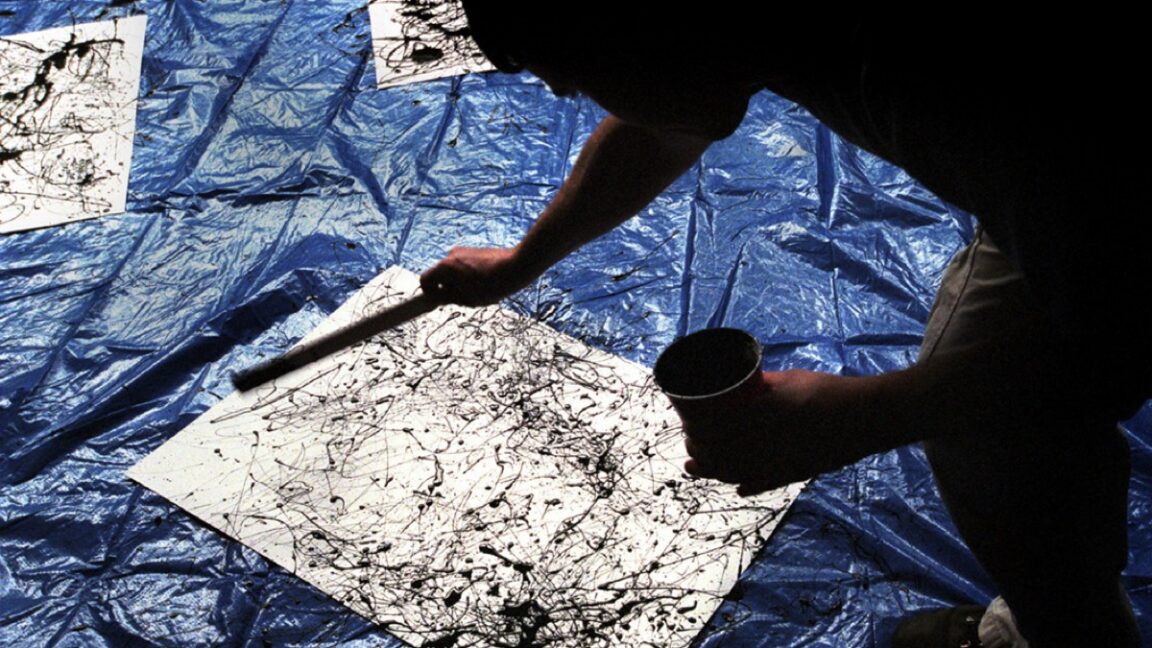Science
Study Reveals Kids’ Drip Paintings Mirror Pollock More Closely

Recent research has demonstrated that drip paintings created by young children resemble the works of influential artist Jackson Pollock more closely than those produced by adults. This finding, published in the journal Frontiers in Physics, offers new insights into the relationship between art and the physical dynamics of painting, particularly through the lens of fractal analysis.
The study, co-authored by physicist Richard Taylor from the University of Oregon, builds on his earlier work identifying fractal patterns in Pollock’s drip paintings. While Taylor initially faced skepticism from both art historians and fellow scientists, recent developments have validated his research. A 2015 study achieved a remarkable 93 percent accuracy in distinguishing genuine Pollock works from forgeries, while a subsequent paper in 2024 reported an even higher accuracy rate of 99 percent.
Taylor’s current investigation focused on the artistic output of 18 children aged four to six and 34 adults aged 18 to 25. This age difference was crucial, as it allowed for a comparative analysis of biomechanical balance, which plays a significant role in the creation of splatter art. The children produced paintings with smaller, fine-scale patterns and fewer gaps between paint clusters, while the adults displayed more varied trajectories and denser paint distributions.
In exploring the mechanics of Pollock’s technique, Taylor noted that the artist’s approach involved pouring paint onto a horizontal canvas, using various tools to achieve different effects. Pollock’s movement around the canvas has often been described as graceful, but Taylor argues that the artist was, in fact, “notoriously clumsy.” He suggests that this clumsiness may have contributed to the unique fractal qualities found in Pollock’s work.
Taylor’s hypothesis posits that Pollock’s struggle with balance may have inadvertently enhanced his artistic expression. By leaning over the canvas, Pollock created a “fractal fluency effect” that produced intricate patterns. This contrasts with the more controlled and uniform patterns seen in adult paintings. “When you look at photographs of Pollock, he leant over more than he had to,” Taylor explained. “He was triggering his physiology to produce this effect.”
The study’s methodology involved not just analyzing the fractal dimensions of the paintings but also assessing “lacunarity,” which examines the variations in gaps between paint clusters. The results showed that while both children and adults exhibited coarse-scale motion, the children’s paintings had less fine-scale structure and more clumping.
Taylor and his team compared their findings to the works of other artists, including Max Ernst, who utilized a controlled pendulum technique, contrasting sharply with Pollock’s free-flowing style. Ernst’s painting fell within the fractal dimensions typical of the children’s artwork, reinforcing the notion that different techniques yield varying results in artistic expression.
Looking ahead, Taylor plans to expand his research by employing motion sensors during future “Dripfests,” where participants create their own splatter paintings. This will allow for a direct comparison of movements and the resulting patterns in their art. He aims to explore further variations in fractal dimensions and lacunarity across different artists who utilize drip or pouring techniques.
The insights gathered from this study not only enhance the understanding of Pollock’s work but also open new avenues for examining the intersection of art and science. The research highlights how physical limitations can influence creativity, drawing parallels with other legendary artists such as Claude Monet and Vincent van Gogh, whose struggles also informed their artistic processes.
The implications of this research extend beyond the realm of art, offering a fascinating perspective on how human physiology impacts creative expression. As Taylor continues to investigate, the world of art may gain a deeper appreciation for the complexities underlying even the simplest forms of creativity.
-

 Science3 months ago
Science3 months agoToyoake City Proposes Daily Two-Hour Smartphone Use Limit
-

 Top Stories3 months ago
Top Stories3 months agoPedestrian Fatally Injured in Esquimalt Collision on August 14
-

 Health3 months ago
Health3 months agoB.C. Review Reveals Urgent Need for Rare-Disease Drug Reforms
-

 Technology3 months ago
Technology3 months agoDark Adventure Game “Bye Sweet Carole” Set for October Release
-

 World3 months ago
World3 months agoJimmy Lai’s Defense Challenges Charges Under National Security Law
-

 Lifestyle3 months ago
Lifestyle3 months agoVictoria’s Pop-Up Shop Shines Light on B.C.’s Wolf Cull
-

 Technology3 months ago
Technology3 months agoKonami Revives Iconic Metal Gear Solid Delta Ahead of Release
-

 Technology3 months ago
Technology3 months agoApple Expands Self-Service Repair Program to Canada
-

 Technology3 months ago
Technology3 months agoSnapmaker U1 Color 3D Printer Redefines Speed and Sustainability
-

 Technology3 months ago
Technology3 months agoAION Folding Knife: Redefining EDC Design with Premium Materials
-

 Business3 months ago
Business3 months agoGordon Murray Automotive Unveils S1 LM and Le Mans GTR at Monterey
-

 Technology3 months ago
Technology3 months agoSolve Today’s Wordle Challenge: Hints and Answer for August 19









